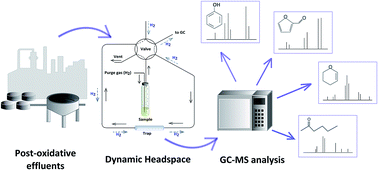Application of dynamic headspace and gas chromatography coupled to mass spectrometry (DHS-GC-MS) for the determination of oxygenated volatile organic compounds in refinery effluents†
Abstract
The paper presents a new procedure for the determination of oxygenated volatile organic compounds (O-VOCs) in postoxidative effluents from the production of petroleum asphalt using dynamic headspace coupled to gas chromatography-mass spectrometry in the selected ion monitoring (SIM) mode (DHS-GC-MS). Among the GC capillary columns tested, a polar SLB-IL111 column with the ionic liquid stationary phase was found to be superior due to its high selectivity for n-alkanes and individual oxygenated volatile organic compounds. The low detection limit, good reproducibility and a wide linear range allows determination of O-VOCs at low concentration levels and applicability of the procedure to routine analyses of O-VOCs in industrial effluents with a very complex composition. The developed procedure was used for the analysis of real samples – raw effluents from the production of bitumens and effluents treated chemically through oxidation. Thirteen compounds at concentrations ranging from 0.01 μg mL−1 to 118.61 μg mL−1 were identified in the effluents. In addition, nine more compounds, mostly alcohols, aldehydes and ketones, were identified using the SCAN mode. The paper demonstrates the need for monitoring O-VOCs in processes of chemical treatment of effluents. Due to the pathways of oxidation of organic pollutants present in effluents, O-VOCs become secondary pollutants. A substantial increase in the concentration of some groups of compounds, i.e. phenol and its derivatives and aliphatic and cyclic alcohols, was found in oxidized effluents. The presence of these compounds has a negative effect on the activated sludge used in refinery wastewater treatment plants.


 Please wait while we load your content...
Please wait while we load your content...